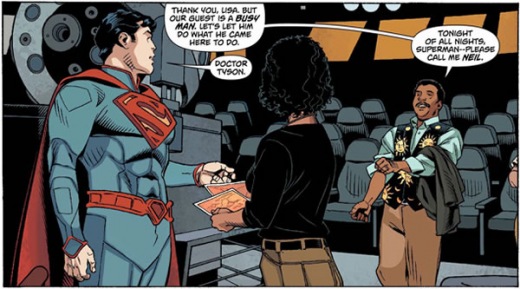World famous Astrophysicist makes a special cameo in an upcoming issue of Superman where he is actually credited with discovering the planet Krypton. Well, he finds where it was, before it went kablooey.
Here is what Phil Plaitt of Bad Astronomy had to say about it:
I’ve often wondered exactly what kind of star Krypton orbited and where it was. Up until now all we’ve known is that it was red, and red stars come in many flavors, from dinky red dwarfs with a tenth the mass of the Sun up to massive supergiants like Betelgeuse which outweigh the Sun by dozens of times (I’ll note that a deleted scene in “Superman Returns” indicates it’s a red supergiant).
Well, that’s about to change. DC comics is releasing a new book this week – Action Comics Superman #14 – that finally reveals the answer to this stellar question. And they picked a special guest to reveal it: my old friend Neil Tyson.
Actually, Neil did more than just appear in the comic: he was approached by DC to find a good star to fit the story. Red supergiants don’t work; they explode as supernovae when they are too young to have an advanced civilization rise on any orbiting planets. Red giants aren’t a great fit either; they can be old, but none is at the right distance to match the storyline. It would have to be a red dwarf: there are lots of them, they can be very old, and some are close enough to fit the plot.
I won’t keep you in suspense: the star is LHS 2520, a red dwarf in the southern constellation of Corvus (at the center of the picture here). It’s an M3.5 dwarf, meaning it has about a quarter of the Sun’s mass, a third its diameter, roughly half the Sun’s temperature, and a luminosity of a mere 1% of our Sun’s. It’s only 27 light years away – very close on the scale of the galaxy – but such a dim bulb you need a telescope to see it at all (for any astronomers out there, the coordinates are RA: 12h 10m 5.77s, Dec: -15° 4m 17.9 s).

